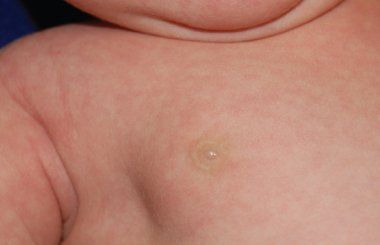Galactorrhea of the Newborn (Witch’s Milk)
The mother of a 5-week-old boy was concerned about a swelling under her infant’s right nipple. A 2-cm, movable subareolar mass was palpated on examination.
The mother of a 5-week-old boy was concerned about a swelling under her infant’s right nipple. A 2-cm, movable subareolar mass was palpated on examination. No redness was noted around the nipple, and no tenderness was appreciated. Gentle pressure on the mass caused a small amount of white milky substance to exude from the nipple.

Galactorrhea of the newborn (neonatal milk or witch’s milk) occurs in about 5% of neonates and in both sexes.1,2 The term “witch’s milk” comes from ancient folklore that fluid leaking from a newborn’s nipple was a source of nourishment for witches’ familiar spirits.3 Galactorrhea is the result of the influence of the mother’s hormones on the baby before birth.2 The mother’s hormones can persist in the neonate’s body for weeks. Up to 2% of infants secrete milk until 2 months of age.1 Infants with galactorrhea have significantly larger breast nodules than infants without galactorrhea. Galactorrhea is more likely to be seen in infants who are nursed and is relatively uncommon in premature infants.
The condition usually resolves spontaneously within a few months. No treatment is necessary unless the area becomes red or tender. Discourage massage or manipulation of the breast tissue because it may force bacteria into the milk glands, which can lead to mastitis.4,5
This infant’s mother was reassured about the benign nature of the condition and encouraged to continue nursing. She was also cautioned against massaging or unnecessarily manipulating the breast tissue.
References:
REFERENCES:
1. Madlon-Kay DJ. Witch’s milk. Galactorrhea in the newborn. Am J Dis Child. 1986;140:252-253.
2. Sanfilippo JS. Gynecological disorders of childhood. In: Behrman RE, Kliegman RM, Jenson HB, eds. Nelson Textbook of Pediatrics. 17th ed. Philadelphia: Saunders; 2004:1834.
3. Potts M, Short R. Ever Since Adam and Eve: The Evolution of Human Sexuality. Cambridge, United Kingdom: Cambridge University Press; 1999:145.
4. Schaffer AJ, Avery ME. Diseases of the Newborn. 3rd ed. Philadelphia: WB Saunders; 1971:685-686.
5. Wammanda RD. Images in clinical practice: bilateral neonatal breast enlargement associated with mastitis. Ann African Med. 2004;3:45. https://tspace.library.utoronto.ca/bitstream/1807/4075/1/am04013.pdf. Accessed September 21, 2010.